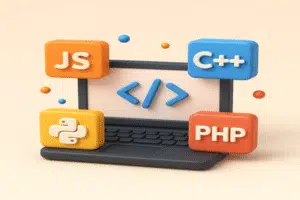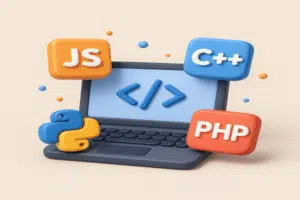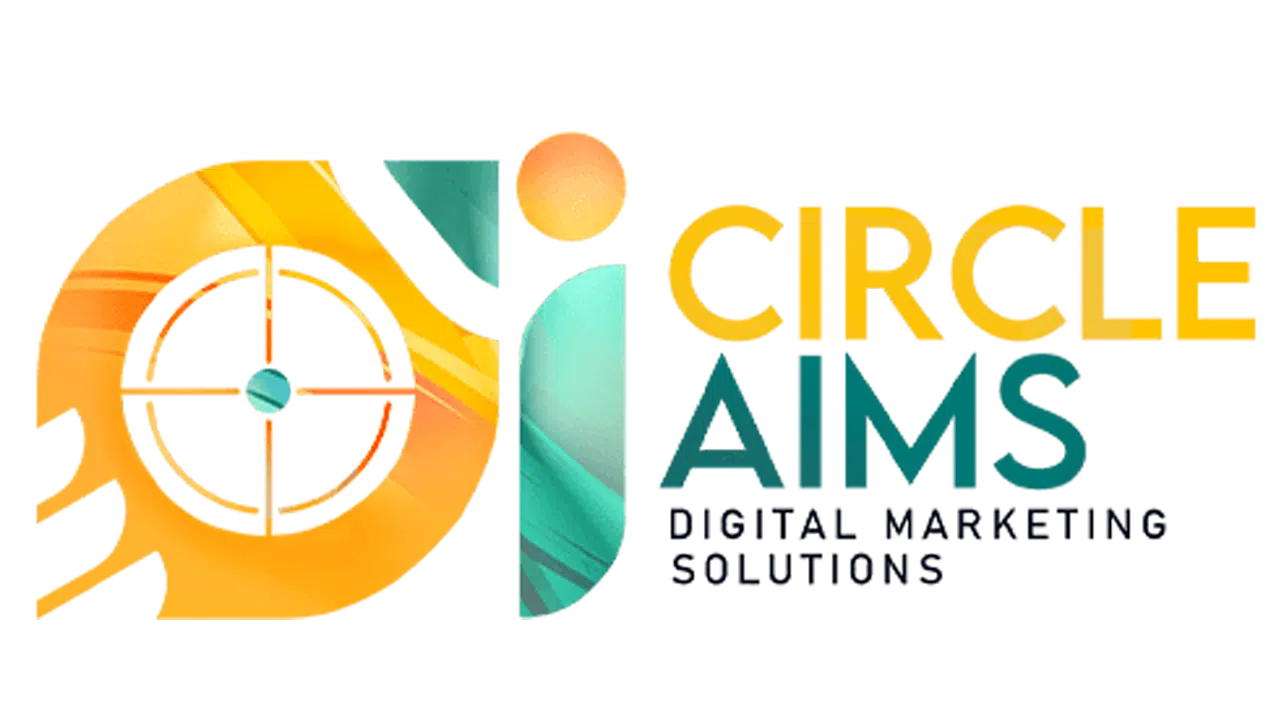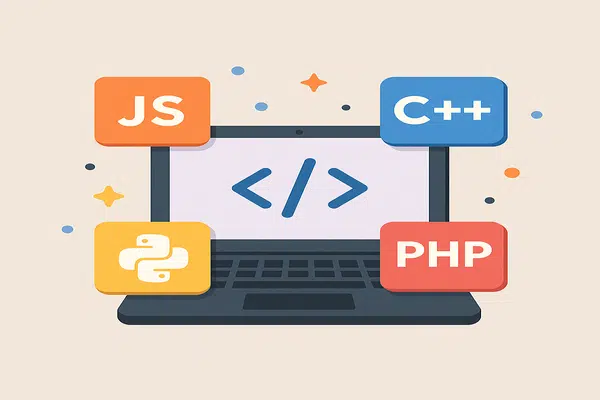Programming Languages
Introduction to Programming Languages
Programming languages are fundamental elements of modern technology. They represent the means by which programmers communicate with computers and instruct them to perform specific tasks. Programming languages are defined as a set of rules and expressions that allow developers to write code that machines can execute. The history of programming languages reflects continuous evolution, with various types emerging to meet different programming needs, starting from simple languages like Pascal to advanced ones like Python and Java.
Programming languages form the foundation of software development, as they define how applications interact with hardware and systems. These languages play a pivotal role in running the applications we use daily, whether on smartphones or computers. Mastering programming languages requires understanding many essential features, including syntax and available functions, which help write efficient and executable code.
Programming languages vary according to different uses, and each has unique characteristics. For instance, scripting languages like JavaScript are primarily used in user interface development, while low-level languages like C are used in operating systems and system programming. Understanding the basic elements of programming languages is a crucial step for anyone aiming to enter this field. As technologies evolve, the demand for learning programming languages continues to grow, making it an essential modern skill.

The History of Programming Languages
Programming languages are a cornerstone of the world of technology and information, having gone through several stages since their initial use. The roots of programming languages date back to the 1950s with the introduction of Assembly language, a low-level language based on direct processor instructions. It was used to develop the software needed to operate machines. As time progressed, the Fortran language appeared in 1957, considered one of the first high-level programming languages, specifically designed for scientific and engineering calculations.
In the 1970s, programming languages began to evolve toward greater complexity and the ability to handle various programming challenges, with the emergence of the C language. C became a standard for many modern programming languages, allowing developers to create efficient and powerful programs. Entering the 1980s, other languages like Pascal and Ada appeared, contributing to improved software development and increased reliability.
With the start of the 1990s, languages such as C++ emerged, an extension of C, adding more object-oriented programming elements. Java, released in the mid-1990s, gained widespread popularity due to its portability and security. In recent years, languages like Python and JavaScript have evolved, offering multi-purpose functionality and significant power in web development and artificial intelligence systems. These milestones have marked key turning points in the history of programming languages and helped shape the future of programming as we know it today.
Types of Programming Languages
Programming languages are essential tools for communication between humans and machines and are classified into different types based on their characteristics and uses. Among the prominent types are high-level languages, designed to be close to natural language, making them easy to understand and learn. Examples include Python and Java, widely used in software and web application development.
On the other hand, there are low-level languages, such as Assembly and Machine Language, which are more complex but provide greater control over system resources. These languages closely reflect how devices operate, making them preferred in the development of high-performance programs such as operating systems and video games.
Additionally, there are interpreted languages that execute instructions line by line during runtime, like PHP and Ruby. These languages accelerate development and simplify testing. Conversely, compiled languages require code translation into machine language before execution, such as C++ and Java. This method provides higher performance efficiency but may require more development time.
Ultimately, each type of programming language has its pros and cons. Programmers must choose the right type according to the project’s requirements and work environment. By understanding the different components of programming languages, developers can make informed decisions to achieve excellent results in their software.
Most Popular Programming Languages Today
Programming languages are vital tools that contribute to application and software development. Among the most widely used programming languages today, Python tops the list due to its simplicity and flexibility. Python is extensively used in scientific applications, data analysis, and machine learning, making it an ideal choice for researchers and developers with diverse skill levels.
Java is also one of the most prominent programming languages, primarily adopted for web applications and information systems development. One of its key features is its cross-platform capability, thanks to the “write once, run anywhere” principle. Its use in developing Android apps also enhances its position in the market.
C# holds a distinguished place as well. Designed to facilitate application development across different environments, such as the .NET framework, C# is commonly used in game development, desktop applications, and enterprise software. It offers a range of advanced features suitable for large and complex projects.
JavaScript, on the other hand, is the core language for web development. It enables the creation of interactive web pages and user experiences. JavaScript is an integral part of frontend development and is also used in server-side development via Node.js. JavaScript enhances website performance and provides a smooth user experience, making it essential in the modern programming world.
Each of these languages has its unique features and specific applications, making them favored in certain fields within the history of programming languages. They exemplify the ongoing advancements in the programming world and meet the needs of developers and various market sectors.
How to Choose the Right Programming Language
Choosing the right programming language can significantly impact a project’s success and efficiency. Programmers should consider several criteria when making this decision. First, project goals must be clearly defined. If the goal is web application development, languages like JavaScript or Python may be the best fit. For projects involving mobile apps, Swift and Kotlin might be the right choices.
Second, the programmer’s level of experience should be taken into account. For some developers, simpler programming languages like Ruby or PHP may be a suitable choice to ease learning and understand fundamental concepts. More advanced programmers may prefer languages like C++ or Rust, which offer more control and flexibility. It is also essential to consider the support community around the language, as strong communities provide valuable resources such as examples, technical support, and helpful tutorials.
Third, the programming language should align with market demands. Programmers must understand current industry trends and which programming languages are most in demand. For instance, Python is popular in machine learning and data fields, while Java performs well in large-scale systems development. Therefore, it’s essential to research the in-demand programming language components in the market and align them with the project’s goals and the programmer’s aspirations.
Future Trends in Programming Languages
Programming languages continue to evolve to meet the increasing need for advanced technology and the nature of large-scale projects. Among the most prominent current and future trends is the growing integration of artificial intelligence concepts within programming languages. Languages like Python are at the forefront in AI fields, offering libraries and frameworks known for their ease and efficiency in processing and analyzing data. Additionally, object-oriented programming continues to trend toward maintaining data structure and classification, enabling developers to build complex projects more efficiently.
The design and new global standards also broaden the scope for programming languages to handle big data. With the growing volume of data analysis, languages like R and Scala have improved in handling and analyzing large data sets. These languages offer powerful tools for users to manage large-scale data dimensions and achieve accurate and immediate results.
Furthermore, language frameworks are no longer limited by budget or mainstream technology. With the emergence of new programming tools like GraphQL, software developers are moving towards building more flexible and faster interfaces. These technologies offer innovative ways to collect and process data.
It is clear that programming language elements are evolving to meet the increasing demands of the digital world, and the innovation process will continue to include more advanced features in the future. Therefore, programmers must stay updated with the latest trends to understand how they can impact their upcoming projects.
Learning Programming Languages: Resources and Tools
Learning programming languages is essential in today’s digital era, and there are many resources and tools available to help beginners start their journey. Online courses are among the most accessible educational options. Platforms like Coursera, edX, and Udacity offer comprehensive content on the history of programming languages and their essential elements, making it easier to understand the various types of programming languages. These courses often include videos, practical exercises, and final projects that reinforce the acquired knowledge.
In addition to courses, books and articles are valuable tools for enhancing knowledge of programming languages. Many books cover the features of different languages and provide examples of popular ones such as Python and JavaScript. These resources allow learners to gain deep understanding and also learn how to apply what they’ve studied in real-world projects. For example, the book Automate the Boring Stuff with Python is an excellent source for beginners.
One should not overlook the importance of online communities and forums, such as Stack Overflow and Reddit, where learners can ask questions and share knowledge. These communities provide significant support, as others’ experiences help overcome challenges. Also, joining local groups or support workshops can enhance self-learning and collaboration with others.
There are many options available for learners in this field, making the acquisition of programming skills more accessible and achievable. By diversifying learning sources and benefiting from courses, books, and communities, learners can develop a comprehensive understanding of programming languages and related topics.
The Importance of Practicing Programming
Practicing programming is a fundamental part of learning programming languages effectively. Regardless of how strong the theoretical knowledge is, one cannot become a skilled programmer without actual practice. Applying the learned knowledge to real projects or problems enhances the deep understanding of various programming language components. The programmer becomes capable of seeing how code and technologies interact, helping reinforce learning and encourage creativity in using these elements.
There are several ways to practice programming effectively. First, new programmers can start by building simple projects to enhance their practice and apply what they’ve learned. For example, they can develop small applications or simple games, allowing them to interact with various types of programming languages and apply the features that govern coding. Second, joining online programming communities or participating in workshops are effective methods to improve skills. These communities provide support and encouragement for beginners, in addition to opportunities to learn from experienced developers.
Programmers can also benefit from educational platforms that offer challenges and programming levels, which provide examples of used programming languages and teach how to approach problems logically. It’s important to focus on practicing across various fields, from web to mobile app development, as these strategies enhance comprehensive programming understanding.

Conclusion
Programming languages represent the foundation upon which the modern digital world is built. From the history of programming languages to their key elements, every aspect of this field intertwines with the rapid technological progress we are witnessing. We have reviewed the different types of programming languages, including high-level and mid-level languages, each reflecting specific characteristics that meet a variety of needs. Examples such as Python, Java, and C# show how these tools can foster innovation and solve complex problems.
In light of the discussion, it is clear that learning programming languages is a vital investment not only for professionals but also for enthusiasts. These skills offer a significant opportunity to advance careers and enhance creativity. To face the challenges of the future, it is essential to continuously seek to strengthen our knowledge and understanding of programming. Once we immerse ourselves in the world of programming, we begin to explore new horizons and unlock possibilities that may not be visible to others.
Therefore, there is a call to engage with this field and commit to ongoing learning. Whether you are a beginner or a professional, knowing one or more programming languages can enhance your opportunities in a fast-paced, ever-changing world. In the end, the programming community is a connected one that supports development and progress, making it essential that we become part of it. Let’s seize the available opportunities, not just consume technology — let’s create it.



No comment